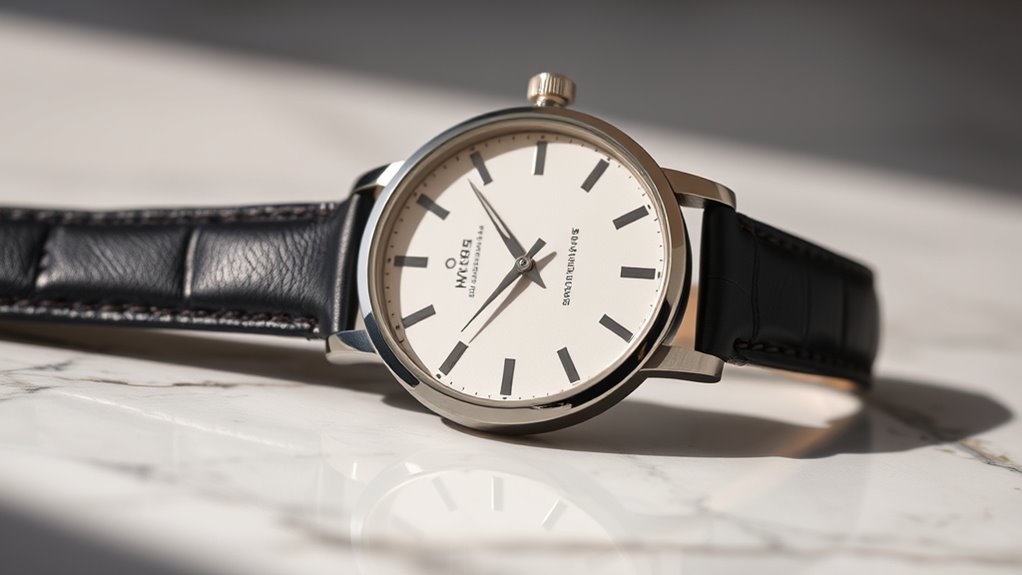To achieve the perfect look, choose a dress watch with a case size between 36mm and 40mm for a sleek, comfortable fit. Opt for a minimalist dial with simple markers and neutral colors, ensuring a clean, uncluttered appearance. Keep the thickness slim so it slides easily under cuffs and maintains an elegant profile. Paying attention to balanced proportions and refined details will give your watch a versatile, sophisticated style—if you continue exploring, you’ll discover even more tips to perfect your choice.
Key Takeaways
- Aim for case sizes between 36mm and 40mm for a balanced, elegant fit on the wrist.
- Opt for minimalist dial designs with simple markers and neutral colors to maintain understated sophistication.
- Ensure proportions of case, dial, and lugs are harmonious for a seamless, refined appearance.
- Keep the case thickness slim to enhance comfort and preserve a sleek, dressy silhouette.
- Prioritize overall balance and subtlety to create versatile watches that complement formal attire elegantly.

When it comes to dress watches, proportions and aesthetics are key to achieving a refined and elegant look. You want a timepiece that complements your wrist without overwhelming it. The case size plays a vital role here. Typically, a dress watch features a case size between 36mm and 40mm. This range ensures the watch fits comfortably on your wrist, maintaining a sleek silhouette without appearing bulky. Larger cases tend to draw unnecessary attention and can disrupt the understated elegance that dress watches aim for. Conversely, too small a case might look out of proportion or diminish the watch’s visual presence. The goal is harmony: a case size that balances well with your wrist’s size and your overall style. Smart design principles suggest that proportion and balance are essential to creating a cohesive, refined appearance.
Equally important is the dial design. A minimalist, clean dial is a hallmark of dress watches. You should look for dials with simple markers, subtle textures, and minimal clutter. The dial’s layout should be balanced and easy to read at a glance. Classic designs often feature stick or baton indices, with a small seconds subdial or none at all. The color palette tends to stay neutral—white, black, or silver—allowing the watch to seamlessly match formal attire. Avoid overly complicated or busy dials, as they detract from the watch’s elegance. A well-designed dial enhances the overall aesthetic, guaranteeing the watch remains sophisticated and versatile.
Proportions extend beyond just case size and dial design; they influence how the watch interacts with your wrist and complements your attire. A well-proportioned dress watch will have a thin case height, making it sit flush against your wrist and slide easily under shirt cuffs. Thickness matters because a bulky watch can look intrusive and feel uncomfortable. The lugs, which connect the case to the strap, should be proportionate as well, aligning with the case size to create a seamless, balanced appearance. When all these elements work together—case size, dial design, thickness, and lug proportions—the result is a watch that exudes understated elegance.
Ultimately, choosing a dress watch isn’t just about the brand or features; it’s about finding a piece with harmonious proportions and refined aesthetics. Pay attention to the case size and dial design, ensuring they suit your wrist and personal style. When these elements are well-considered, your dress watch becomes a subtle yet powerful accessory that elevates your entire look.
Frequently Asked Questions
How Do Dress Watch Proportions Vary Across Different Brands?
You’ll notice that brand-specific design influences dress watch proportions, with some brands favoring slim, minimalist cases and others opting for slightly larger, more prominent styles. Proportion variations across brands reflect their unique aesthetics and target audiences. For instance, luxury brands tend to keep proportions sleek and refined, while fashion brands may experiment more. Ultimately, understanding these differences helps you choose a dress watch that best fits your style and wrist size.
What Materials Are Preferred for Aesthetically Balanced Dress Watches?
For an aesthetically balanced dress watch, you prefer materials that combine material durability with elegance. Stainless steel and gold are popular choices for their durability and timeless appeal, while ceramic and platinum offer a sleek look and resistance to scratches. You also focus on color harmony, choosing metals and dials in subtle tones like silver, white, or black that complement formal attire and maintain a refined, cohesive appearance.
How Do Wrist Size and Watch Size Correlate in Dress Watch Selection?
Did you know that 60% of watch enthusiasts find that a perfect wrist-to-watch ratio creates a look of proportional harmony? When selecting a dress watch, consider your wrist size; smaller wrists typically look best with watches under 40mm, while larger wrists can handle slightly bigger models. By matching your wrist size with a proportionally balanced watch, you enhance elegance and comfort, making your accessory feel naturally right.
Are There Cultural Differences Influencing Dress Watch Proportions?
Yes, cultural design influences and regional aesthetic preferences shape dress watch proportions. In Western cultures, slim, minimalist watches are preferred, emphasizing elegance and subtlety. Meanwhile, Asian markets might favor slightly larger designs with intricate details, reflecting local aesthetics. You’ll notice that these regional differences influence watch styles, size, and proportions, so when selecting a dress watch, consider these cultural factors to guarantee your choice aligns with regional tastes and personal style.
How Do Vintage Dress Watches Compare in Proportions to Modern Designs?
You might think vintage dress watches are oversized relics, but they actually emphasize elegance with smaller, more refined proportions. Modern designs often lean toward boldness, sacrificing subtlety. While vintage pieces stick to a classic formality level, their color palette choices tend to be subdued, enhancing versatility. Ironically, today’s larger watches may seem more casual, yet they often clash with the timeless aesthetic of vintage proportions, which prioritize understated sophistication.
Conclusion
Ultimately, paying attention to dress watch proportions and aesthetics makes all the difference—you might find yourself glancing at your wrist and realizing it’s perfectly suited for any occasion. Sometimes, it’s funny how a watch’s subtle elegance can unexpectedly elevate your entire look, almost as if it was meant to be. So, trust your eye, choose wisely, and embrace how the right proportions can effortlessly make your style feel complete, almost by coincidence.









